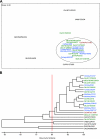Characterization of low-pathogenic H5 subtype influenza viruses from Eurasia: implications for the origin of highly pathogenic H5N1 viruses
- PMID: 17507485
- PMCID: PMC1933357
- DOI: 10.1128/JVI.00327-07
Characterization of low-pathogenic H5 subtype influenza viruses from Eurasia: implications for the origin of highly pathogenic H5N1 viruses
Abstract
Highly pathogenic avian influenza (HPAI) H5N1 viruses are now endemic in many Asian countries, resulting in repeated outbreaks in poultry and increased cases of human infection. The immediate precursor of these HPAI viruses is believed to be A/goose/Guangdong/1/96 (Gs/GD)-like H5N1 HPAI viruses first detected in Guangdong, China, in 1996. From 2000 onwards, many novel reassortant H5N1 influenza viruses or genotypes have emerged in southern China. However, precursors of the Gs/GD-like viruses and their subsequent reassortants have not been fully determined. Here we characterize low-pathogenic avian influenza (LPAI) H5 subtype viruses isolated from poultry and migratory birds in southern China and Europe from the 1970s to the 2000s. Phylogenetic analyses revealed that Gs/GD-like virus was likely derived from an LPAI H5 virus in migratory birds. However, its variants arose from multiple reassortments between Gs/GD-like virus and viruses from migratory birds or with those Eurasian viruses isolated in the 1970s. It is of note that unlike HPAI H5N1 viruses, those recent LPAI H5 viruses have not become established in aquatic or terrestrial poultry. Phylogenetic analyses revealed the dynamic nature of the influenza virus gene pool in Eurasia with repeated transmissions between the eastern and western extremities of the continent. The data also show reassortment between influenza viruses from domestic and migratory birds in this region that has contributed to the expanded diversity of the influenza virus gene pool among poultry in Eurasia.
Figures



References
-
- Alexander, D. J. 2000. A review of avian influenza in different bird species. Vet. Microbiol. 74:3-13. - PubMed
-
- Banks, J., E. S. Speidel, E. Moore, L. Plowright, A. Piccirillo, I. Capua, P. Cordioli, A. Fioretti, and D. J. Alexander. 2001. Changes in the haemagglutinin and the neuraminidase genes prior to the emergence of highly pathogenic H7N1 avian influenza viruses in Italy. Arch. Virol. 146:963-973. - PubMed
-
- Bray, R. J., and J. T. Curtis. 1957. An ordination of the upland forest communities of southern Wisconsin. Ecol. Monogr. 27:325-349.
-
- Campitelli, L., E. Mogavero, M. A. De Marco, M. Delogu, S. Puzelli, F. Frezza, M. Facchini, C. Chiapponi, E. Foni, P. Cordioli, R. Webby, G. Barigazzi, R. G. Webster, and I. Donatelli. 2004. Interspecies transmission of an H7N3 influenza virus from wild birds to intensively reared domestic poultry in Italy. Virology 323:24-36. - PubMed
-
- Chen, H., G. J. D. Smith, S. Y. Zhang, K. Qin, J. Wang, K. S. Li, R. G. Webster, J. S. M. Peiris, and Y. Guan. 2005. H5N1 virus outbreak in migratory waterfowl. Nature 436:191-192. - PubMed
Publication types
MeSH terms
Grants and funding
LinkOut - more resources
Full Text Sources
Medical

